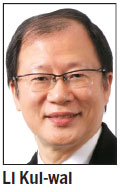The way forward for the MPF scheme
Updated: 2014-07-25 04:33
By Li Kui-Wai(HK Edition)
|
|||||||||
There has been much discussion about the aging population of Hong Kong. But a voluntary retirement scheme was slow in coming to the city. The Mandatory Provident Fund (MPF) was only introduced just over a decade ago. Welfare advocates argue that the provision of life-long post-retirement subsidies should be instituted. But this is easier said than done as the fiscal burden would be immense. Others believe welfare assistance for the elderly should be maintained, but individuals should also be permitted to build up their retirement funds while they are still working.
Many developed countries have established good retirement funds. These allow individuals to save while they work; they can then draw funds following retirement. The introduction of the MPF scheme in Hong Kong is a positive development, but it has also attracted criticism.
High inflation and low returns - resulting from low saving rates - mean the funds run the risk of loosing much of their future value. Secondly, salaries are low and increasing at too slow a rate compared with inflation. Making regular payments into the MPF scheme can become an onerous financial burden for workers. The resultant accumulated retirement funds are invariably small and of little help as prices continue to rise with inflation. The various charges imposed on the MPF funds have also been criticized.

The MPF is a kind of "forced saving" scheme, needed to help protect people's post-retirement lives. A number of questions remain: How much should the funds accumulate? Who should manage the accumulated funds? What are the costs of managing the funds? What future returns will the funds show?
Another concern is how to reduce the risk exposure of the funds. Currently, both employees and employers contribute a fixed percentage. MPF scheme members have a degree of freedom to choose the makeup of their portfolios. Since the funds are privately managed, the charges can vary considerably from one company to another. In many cases scheme members do not possess adequate knowledge to make fund choices to their best advantage.
In June, the Mandatory Provident Fund Scheme Authority (MPFA) released a consultation paper on the introduction of a "core fund" (CF). The idea of this is to enable any scheme member to choose a portfolio comprising secured and low-risk market funds and financial products. This is to facilitate greater stability while reducing exposure to risk. Values will be less likely to fluctuate so as to produce a sense of certainty. Risk-averse scheme members should find the CF an attractive proposition. The charges suggested in the consultation paper will be capped at 0.75 percent. The major advantage of the CF is that it does provide an alternative to existing funds and the CF has decided (and made known in advance) what kind of financial funds will be included in the portfolio. Hence scheme members will know that the risks associated with the CF should be lower than for other funds.
However, there are a number of unanswered questions in the consultation paper. One is the charges. In all cases, these are imposed whether the fund has increased or decreased in market value. In other words, scheme members may still have to pay management fees or other charges even when the fund prices are declining. The fund management will impose charges in both winning and losing situations. This may not be fair to scheme members. It is more ethical if management also shares the financial burden should the funds lose market value. There should be "penalty" charges on fund management for a poor job in downsizing the value of accumulated funds.
Secondly, should the same 0.75 percent be charged throughout the entire period? They are talking about a period of three or four decades in regard to salary earners. As the fund value rises, the same percentage charge will mean an increase in the absolute value paid for fund management. If the fund is for the protection of its scheme members, the percentage charge should decline proportionately to the number of years (or the size of the funds the account has acquired). For example, if the scheme member has engaged in the fund for 10 years, the percentage charge should be lowered proportionately. However, the fee paid in absolute terms will remain the same.
The consultation paper did not specify whether the CF will be established by private financial institutions or whether the government will establish such a fund as an alternative. If the CF is to be established by the private sector, will the new fund be acceptable to them? Given that there are already numerous fund choices in the market, what will be the advantages in establishing the new CF? If eventually the CF is established by the private sector, will the charges be lower than existing charges? If the CF is also made up of existing - though less risky - types of funds, how will scheme members be able to distinguish them from other existing funds in the market?
The consultation paper is probably the first step in shaping a future retirement scheme for Hong Kong. But it is more important to establish a long-lasting, effective, sustainable and transparent system which benefits everyone.
The author is an associate professor of the Department of Economics and Finance at City University of Hong Kong.
(HK Edition 07/25/2014 page9)